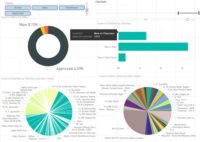Construction has traditionally lagged behind other industries in adopting new technologies. Contributing factors include the siloed nature of the design and construction process and the cost of training and implementing new technologies in businesses with historically narrow profit margins.
However, the increased acceptance of integrated project delivery and design/build as delivery approaches have highlighted the need for increased collaboration and information transparency among all project participants, including client stakeholders.
In addition, design and construction projects are inherently complex. With evolving deliverables (drawings, schedules, budgets) produced by multiple companies, a tiny, missed detail or an incorrect calculation can impact a project significantly if not identified in time. The increased use of BIM—more specifically, shared 3D models— is an excellent indicator of how construction can adopt and leverage technology to enhance information sharing and become connected.
Connected construction has many definitions in the industry, but all share a focus on communication through a single, connected technology platform to facilitate data integration across teams and stakeholders. By implementing a connected approach, all project participants have access to pertinent project data in real-time, increasing efficiency and reducing the potential for error.
Investment Indicates Growth and Increased Industry Acceptance
Although BIM has been in use for decades, the investment in software technology is exploding and is expected to triple from $6.91 Billion in 2021 to a projected $18.73 Billion by 2028, according to a study released by market research firm BrandEssence. Additional research by McKinsey & Company shows that investment in design and construction coordination technology has more than doubled in the past decade. These investment trends, combined with project team and stakeholder frustration navigating a proverbial sea of software applications, are contributing to a potential ‘technology tsunami’ that will significantly impact the construction industry.
Key Implementation Considerations
While there is considerable consensus across the construction community regarding the benefits of a connected approach, there are key considerations to be addressed:
- Ownership of the Technology Platform: Perhaps the most vexing aspect of implementing a connected approach is determining who owns or hosts the platform. On most projects, design activities are initiated well before a contractor or construction manager is engaged. A case could be made for having the architect own the technology platform for information sharing. However, most technology platforms in the construction industry are focused on contractor information integration. Owners who have large capital planning and construction departments would benefit from hosting the platform with future aspirations of data life-cycle and facilities management use.
- Knowledge Sharing vs, Security: The value proposition of the connected approach is increased knowledge sharing to facilitate decision-making. Regardless of what entity owns or hosts the technology platform, security and access are extremely important items to address. Multi-factor identification, redundancy, and compartmentalized permissions are strategies that can be implemented to ensure information is kept secure.
- Contractual Language: Just as the construction industry had to revise contracts to support IPD project delivery, connected projects will also require revised contract language. Technology language must be put into the contracts and require more detail than has been used to address BIM model sharing. As more and more collaborative platforms and data exchange programs are introduced, technology-centered inserts regarding data translation and handoffs will need to be developed.
- Determine Communication Methods: Determine how best to communicate among team members. What is holding you up about your current communication system? Texting and sending images have become more popular than email these days. Things aren’t any different in the construction/design world. To ensure the entire team is aware of an issue or decision, the message should be sent through the connected platform so it is trackable and also accessible on a mobile device or computer.
- Stakeholder Training: Investing in a robust technology platform requires that all project stakeholders are trained in order to reap the benefits. Change is difficult for many people. Information hoarding and outdated workflow processes can significantly impact productivity and efficiency. A project onboarding training program that team members can access through video or online / on-demand tutorials will help all participants understand the benefits of the Connect Construction approach.
Looking to the Future
Technology is helping owners, architects, contractors, and suppliers redefine and improve how projects are being delivered.
Industry leaders recognize that current processes are not agile or flexible enough to accommodate change and lack the foresight to envision the operating reality for years in the future.
At the same time, leaders and project stakeholders look to optimize the exchange of information, views, practices, and policies related to capital planning and execution issues faced by owners. By optimizing this exchange, they enact broad, effective owner representation and increased owner leadership on construction issues in order to create a competitive advantage and unlock value blocked by today’s engineering and construction practices.
As the construction industry begins to embrace technology and adopt connected, best practices on a greater scale, both the industry and the built environment have the potential to be radically transformed. As an industry, we need to commit to leveraging new technologies and ideas as they emerge, as they will improve efficiency, productivity, and profitability.
Lauren Collier, Associate AIA, is the Department Manager, VDC Global Initiatives and Senior Associate at SSOE Group, an internationally ranked architecture and engineering firm. Her creative passion lies in Lean, continuous improvements, and innovative model / data use solutions for design and construction operations. Lauren leads a group of VDC technical leaders and model managers whose focus is implementing new innovative technologies and best practices in design and construction. She can be reached in SSOE’s Toledo, Ohio, office or at lauren.collier@ssoe.com.





Post a comment to this article
Report Abusive Comment